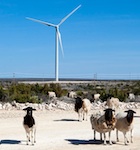Detroit River International Wildlife Refuge Gateway
Detroit
Started
2004
Completed
Ongoing
Size
43 acres
Cost
More than $20 million
Project Type
Urban wildlife refuge
1
Jointly managed by the United States Fish and Wildlife Service (USFWS) and the Canadian Wildlife Service, the DRIWR’s scattered 7.88 square miles of wetland line the shores and islands of the hyperurbanized Detroit River tributary, which empties into Lake Erie. ”This refuge is one of the most urban wildlife refuges in the country and the only international refuge in Michigan,” Anderson says.
Anderson, who has been working on Detroit’s old industrial lands since 1983, had also been involved with the revitalization of the lower eight miles of the Rouge River, a polluted, factory-scorched stretch of property just a few miles away from the DRIWR Gateway. “We started work on the Rouge in 1997, and that work led to our involvement at the refuge,” Anderson says. “When we started on the refuge in 2004, it really became a centerpiece of the natural landscape and restoring ecological systems of the Detroit River.”
“Part of what makes this site unique is its adjacency to the Humbug Marsh, a Ramsar-designated site [in 2010] and the last undeveloped shoreline on the Detroit side of the river,” HAA landscape architect Burke Jenkins adds.
Wayne County Parks, the owner of the DRIWR Gateway property, had acquired the site from Chrysler in 2002 and had plans to turn it into wetlands. So, HAA began consulting with Wayne County and the USFWS to conceptualize a landscape that would accommodate a constructed wetland and that would buffer views and interaction with the river and adjacent natural marsh. The firm also planned for the eventual construction of a visitors center.
“The first phase of the master plan also had to account for the 36-inch storm drain that was running through the site and into the river,” Jenkins says. “As part of the project, we removed a few hundred feet of pipe and created a settling basin and wetland to filter the water before it empties into the river.”
Once home to an automotive plant producing brakes and paint, the site had become flattened by industrial development, so HAA began to incorporate intricate earthwork in the second phase of its master plan. “We wanted to recreate some of the ecological tiers—uplands, lowlands, and wetlands—that once existed in the area.” Anderson says. “Detroit and the region is changing, and this is a key part of that transformation.”
The second phase also included shoreline restoration, which involved the excavation and relocation of an existing landfill to other locations in the refuge, widening the river and breaking up the otherwise blighted shore. During the renewal work, HAA happened upon old building foundations. “We had to mobilize quickly to revise the plans to accommodate and design around these,” Anderson says. “One of the challenges working in a brownfield site is managing unexpected obstacles like this. It’s important to have a team willing to deal with the unforeseen.”
As part of the refuge’s restoration, the USFWS hosted the Wyandot of Anderdon—Native Americans whose homeland includes the Detroit region—at the site and had them perform a blessing ceremony. “This ceremony was a formal recognition of the transition of the land back to the way it was before settlement,” Anderson says.
“One of our primary focus areas is community and urban design,” he adds. “This project is part of our larger relationship with the city of Detroit—and [part of] its rightsizing plan for redesigning urban systems in an area continuing to undergo major transformation.” ABQ



